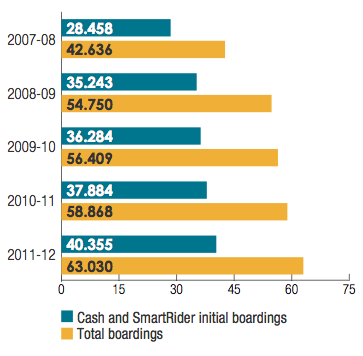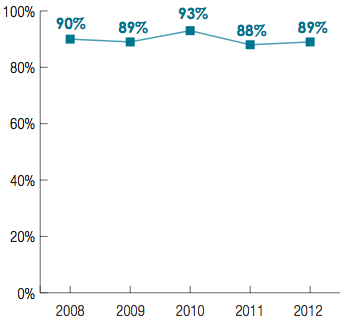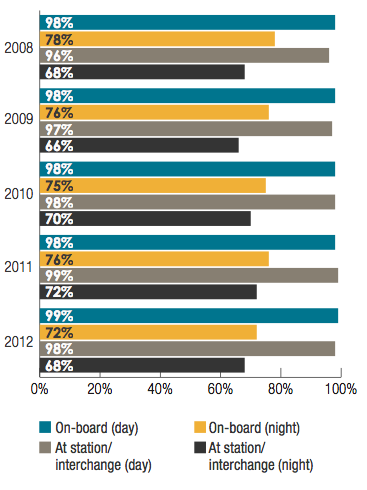Transperth trains
The TTO division operates an electrified suburban train system with more than 1045 services on an average weekday, and more than 6640 weekly services.
The system covers 173.1km of track with 70 stations on five lines, and a fleet of 234 railcars which can be coupled in configurations of two, three, four or six-car trains. The train network consists of the Joondalup Line (33.2km), the Fremantle Line (19km), the Midland Line (16km), the Armadale/Thornlie Line (30.5km, and a 3km spur line to Thornlie), and the Mandurah Line (71.4km).
The year’s developments
- Completed the installation of the platform detection system on A-series railcars - this promotes passenger safety as railcar doors will not open where there is no platform
- Launched the new Central Monitoring Room (CMR) to significantly improve security for all Transperth patrons
- Provided rail services for CHOGM and many other special events
- Started a new railcar maintenance contract with EDI Rail Bombardier Transportation (Maintenance) Pty Ltd (EDI-BT)
- Implemented a number of operational changes to facilitate work on the Perth City Link project to sink the Fremantle Line
- Carried out modification of the internal seating arrangement in B-series railcars to increase capacity
- Conducted a trial of 4am weekend train services.
In the year under review, the train network operated 14.965 million service kilometres, up 4.6 per cent from 14.307m in 2010-11. Total capacity increased 5.2 per cent from 6838.7m passenger place kilometres in 2010-11, to 7192.7m.
Cost of the service
In 2011-12, the total cost of providing Transperth train services, including annual capital charges, was up 3.6 per cent at $392.857 million (previously $379.175m). Annual capital charges (interest and depreciation) increased 1.1 per cent to $153.943m ($152.288m).
Train operating costs increased by 5.3 per cent to $293.914m ($226.887m), due mainly to:
- Increased labour costs - more transit officers and additional cost for customer service
- An increase (about four per cent) in electricity costs
- One-off mobilisation cost for the start-up of the new maintenance contract combined with the close-out of the existing works.
Patronage
Transperth trains: Patronage (millions)
Patronage on Transperth train services increased for the ninth year in succession - total boardings increased 7.1 per cent to 63.030m. This compares with increase of 4.4 per cent in 2010-11 and three per cent in 2009-10. Total boardings on the Armadale Line increased by 4.4 per cent, on the Fremantle Line by 5.9 per cent, the Joondalup Line by seven per cent, the Mandurah Line by 9.6 per cent, and the Midland Line by 4.9 per cent.
Cash and SmartRider initial boardings on the train network (excluding free travel within the FTZ) rose 6.5 per cent to 40.355m, and fare-paying boardings rose 6.6 per cent to 38.584m. This compares with an increase of 4.4 per cent in 2010-11 and a decline 0.5 per cent in 2009-10 following the introduction of free travel for seniors and pensioners. In 2011-12, boardings on special event services fell 12.4 per cent to 1.124m.
Seniors, aged and disability pensioners used their free travel entitlement to complete 2.606m total boardings on trains, an increase of 4.3 per cent from 2.499m in 2010-11.
On a per kilometre basis, the train network recorded an improvement due to patronage increasing faster than service kilometres (which went up 4.6 per cent to 14.965m). Total boardings per service kilometre rose 2.4 per cent from 4.11 in 2010-11, to 4.21 while cash and SmartRider initial boardings per service kilometre went up by 1.8 per cent to 2.697 from 2.648.
PTA in the Community
The PTA carried 1,938,410 people to special events around Perth including CHOGM, ANZAC services, the Royal Show and multiple concerts and sporting events. Of those, 644,790 were patrons going to and from AFL matches.
Passenger satisfaction
The 2012 Transperth PSM showed that 89 per cent of our rail customers are satisfied overall with the train system, compared with 88 per cent in 2011.
Transperth trains: Level of overall customer satisfaction
The improvement reflects actions taken to address passenger concerns with overcrowding, which had led to a slide in satisfaction in 2011, and was achieved despite passengers still facing some inconvenience due to works at Perth Station.
The importance rating of the key service characteristics of Transperth’s train services (other than passenger safety) and the level of satisfaction/dissatisfaction for each key service characteristic are shown in the following table.
In 2012, “time waiting for a connecting bus” replaced “access to ticket purchase facilities” in the top 10 list. “Availability of seats,” the second most important characteristic in 2011, dropped to fifth and was replaced by “cleanliness on board.”
Significantly, the satisfaction rating for most service characteristics remained high, though some were marginally lower than in 2011.
|
Service characteristic |
Importance rating % |
Satisfaction (dissatisfaction) rating % |
||
|---|---|---|---|---|
| 2011 | 2012 | 2011 | 2012 | |
|
Cost of fares |
75 |
72 |
61 (11) |
58 (13) |
|
Cleanliness on board |
62 |
67 |
91 (3) |
92 (3) |
|
Punctuality |
61 |
67 |
94 (2) |
93 (3) |
|
Speed of the trip |
67 |
61 |
92 (2) |
94(2) |
|
Availability of seats |
70 |
60 |
72 (19) |
71 (21) |
|
Service frequency peak times |
51 |
52 |
77 (13) |
76 (14) |
|
Service frequency weekdays |
55 |
48 |
82 (7) |
83 (7) |
|
Time waiting for a connecting bus |
38 |
68 (18) |
||
Passenger safety
The 2012 PSM asked train users: How safe do you generally feel from personal interference or threat from other passengers? The following graph shows the proportion of respondents who always or usually feel safe at specified times/locations.
Transperth trains: Customer perception of safety
Continuing a well-established trend, virtually all rail patrons feel safe during the day. However, the proportion of passengers who feel safe on board at night fell from 76 to 72 per cent and the night station/interchange figure fell from 72 to 68 per cent.
The PTA is committed to ensuring that passengers feel safe on the train network. To help achieve this aim, digitised CCTV footage from all train stations is monitored at the new CMR, a state-of-the-art facility which is manned 24 hours a day, seven days a week.
During the year, an independent review of the security arrangements on the rail network was carried out by an independent consultant. The review found that
the existing arrangement where the PTA, utilising transit officers and contractors, is responsible for security is the ideal model.
Major initiatives for 2012-13
- Provide operational expertise for the Perth City Link project and the extension of the Joondalup Line to Butler
- Continue recruitment of staff to service customer needs on the system
- Plan for the acceptance and commissioning of the next order of 45 railcars (15 three-car sets) starting in late 2013
- Provide input for car park extensions across the network.


